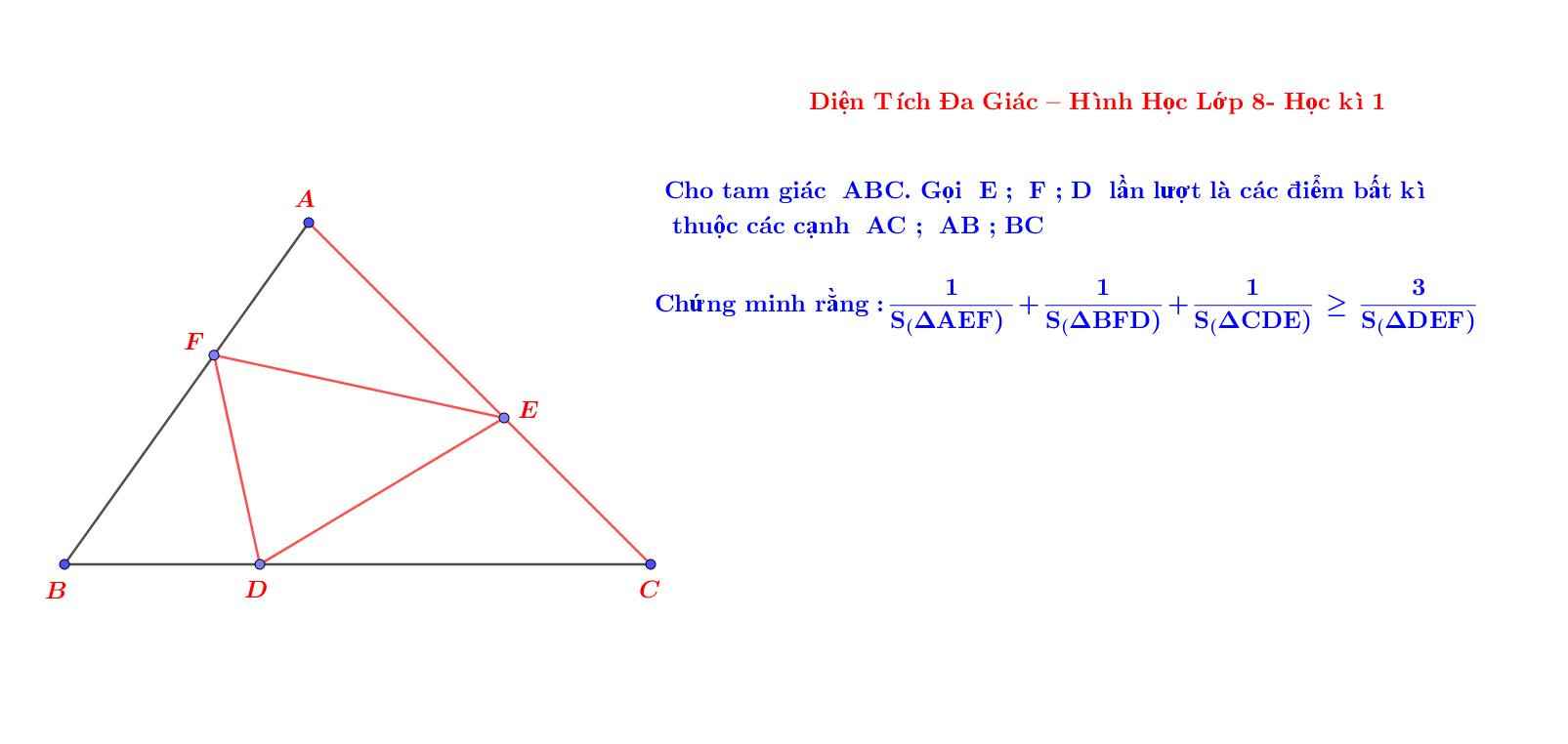Hãy nhập câu hỏi của bạn vào đây, nếu là tài khoản VIP, bạn sẽ được ưu tiên trả lời.

a) Các giao điểm của (E) với trục hoành có tọa độ thỏa mãn hệ phương trình
\(\left\{ \begin{array}{l}\frac{{{x^2}}}{{{a^2}}} + \frac{{{y^2}}}{{{b^2}}} = 1\\y = 0\end{array} \right. \Leftrightarrow \left\{ \begin{array}{l}x \pm a\\y = 0\end{array} \right. \Rightarrow \left\{ \begin{array}{l}{A_1}\left( { - a;0} \right)\\{A_2}\left( {a;0} \right)\end{array} \right.\)
Các giao điểm của (E) với trục tung có tọa độ thỏa mãn hệ phương trình
\(\left\{ \begin{array}{l}\frac{{{x^2}}}{{{a^2}}} + \frac{{{y^2}}}{{{b^2}}} = 1\\x = 0\end{array} \right. \Leftrightarrow \left\{ \begin{array}{l}x = 0\\y = \pm b\end{array} \right. \Rightarrow \left\{ \begin{array}{l}{B_1}\left( {0; - b} \right)\\{B_2}\left( {0;b} \right)\end{array} \right.\)
Ta có \({A_1}{A_2} = 2a,{B_1}{B_2} = 2b\).
b) Do M thuộc (E) nên ta có \(\frac{{x_o^2}}{{{a^2}}} + \frac{{y_o^2}}{{{b^2}}} = 1\)
Do \(a > b > 0\) nên ta có \(\frac{{x_o^2}}{{{a^2}}} \le \frac{{x_o^2}}{{{b^2}}}\). Suy ra \(1 \le \frac{{x_o^2}}{{{b^2}}} + \frac{{y_o^2}}{{{b^2}}} \Rightarrow {b^2} \le x_o^2 + y_o^2\)
Tương tự ta có \(\frac{{y_o^2}}{{{a^2}}} \le \frac{{y_o^2}}{{{b^2}}}\) nên \(1 \ge \frac{{y_o^2}}{{{a^2}}} \le \frac{{y_o^2}}{{{b^2}}} \Rightarrow {a^2} \ge x_o^2 + y_o^2\)
Vậy \({b^2} \le x_o^2 + y_o^2 \le {a^2}\)
Ta có \(OM = \sqrt {x_o^2 + y_o^2} \) suy ra \(b \le OM \le a\)

+) Từ phương trình \({\Delta _1}:{a_1}x + {b_1}y + {c_1} = 0\) ta xác định được tọa độ của vectơ \(\overrightarrow {{n_1}} \) là \(\left( {{a_1};{b_1}} \right)\)
+) Từ phương trình \({\Delta _2}:{a_2}x + {b_2}y + {c_2} = 0\) ta xác định được tọa độ của vectơ \(\overrightarrow {{n_2}} \) là \(\left( {{a_2};{b_2}} \right)\)
+) \(\cos \left( {\overrightarrow {{n_1}} ,\overrightarrow {{n_2}} } \right) = \frac{{\overrightarrow {{n_1}} .\overrightarrow {{n_2}} }}{{\left| {\overrightarrow {{n_1}} } \right|.\left| {\overrightarrow {{n_2}} } \right|}} = \frac{{{a_1}{a_2} + {b_1}{b_2}}}{{\sqrt {{a_1}^2 + {b_1}^2} \sqrt {{a_2}^2 + {b_2}^2} }}\)

a) \(\overrightarrow a \bot \overrightarrow b \Leftrightarrow \overrightarrow a .\overrightarrow b = \overrightarrow 0 \Leftrightarrow {a_1}{b_1} + {a_2}{b_2} = 0\)
b) \(\overrightarrow a \) và \(\overrightarrow b \) cùng phương \( \Leftrightarrow \left\{ \begin{array}{l}{a_1} = t{b_1}\\{a_2} = t{b_2}\end{array} \right.\) hay \(\left\{ \begin{array}{l}{b_1} = k{a_1}\\{b_2} = k{a_2}\end{array} \right.\)
\( \Leftrightarrow {a_1}{b_2} - {a_2}{b_1} = {a_1}.k{a_2} - {a_2}.k{a_1} = 0\)
c) \(\left| {\overrightarrow a } \right| = \sqrt {{{\left( {\overrightarrow a } \right)}^2}} = \sqrt {{a_1}^2 + {a_2}^2} \)
d) \(\overrightarrow {AB} = ({x_B} - {x_A};{y_B} - {y_A}) \Rightarrow AB = \sqrt {{{\left( {\overrightarrow {AB} } \right)}^2}} \)
\( = \sqrt {{{\left( {{x_B} - {x_A}} \right)}^2} + {{\left( {{y_B} - {y_A}} \right)}^2}} \)
e) \(\cos (\overrightarrow a ,\overrightarrow b ) = \frac{{\overrightarrow a .\overrightarrow b }}{{\left| {\overrightarrow a } \right|.\left| {\overrightarrow b } \right|}} = \frac{{{a_1}{b_1} + {a_2}{b_2}}}{{\sqrt {{a_1}^2 + {a_2}^2} .\sqrt {{b_1}^2 + {b_2}^2} }}\)

Dễ dàng c/m : \(\dfrac{1}{a+2}+\dfrac{1}{b+2}+\dfrac{1}{c+2}=1\)
Ta có : \(\dfrac{1}{\sqrt{2\left(a^2+b^2\right)}+4}\le\dfrac{1}{a+b+4}\le\dfrac{1}{4}\left(\dfrac{1}{a+2}+\dfrac{1}{b+2}\right)\)
Suy ra : \(\Sigma\dfrac{1}{\sqrt{2\left(a^2+b^2\right)}+4}\le2.\dfrac{1}{4}\left(\dfrac{1}{a+2}+\dfrac{1}{b+2}+\dfrac{1}{c+2}\right)=\dfrac{1}{2}.1=\dfrac{1}{2}\)
" = " \(\Leftrightarrow a=b=c=1\)

- Nếu \(a_i=0\) ; \(\forall i\in\left(0;n-1\right)\Rightarrow a_nx^n=0\Rightarrow\alpha=0< 1\) thỏa mãn
- Nếu tồn tại \(a_i\ne0\), đặt \(max\left|\dfrac{a_i}{a_n}\right|=A>0\)
Do \(\alpha\) là nghiệm nên:
\(a_n\alpha^n+a_{n-1}\alpha^{n-1}+...+a_1\alpha+a_0=0\)
\(\Leftrightarrow\dfrac{a_0}{a_n}+\dfrac{a_1}{a_n}\alpha+...+\dfrac{a_{n-1}}{a_n}\alpha^{n-1}=-\alpha^n\)
\(\Leftrightarrow\left|\alpha^n\right|=\left|\dfrac{a_0}{a_n}+\dfrac{a_1}{a_n}\alpha+...+\dfrac{a_{n-1}}{a_n}\alpha^{n-1}\right|\)
\(\Rightarrow\left|\alpha^n\right|\le\left|\dfrac{a_0}{a_n}\right|+\left|\dfrac{a_1}{a_n}\right|.\left|\alpha\right|+...+\left|\dfrac{a_{n-1}}{a_n}\right|.\left|\alpha^{n-1}\right|\le A+A.\left|\alpha\right|+...+A.\left|\alpha^{n-1}\right|\)
\(\Rightarrow\left|\alpha^n\right|\le A\left(1+\left|\alpha\right|+\left|\alpha^2\right|+...+\left|\alpha^{n-1}\right|\right)\)
\(\Rightarrow\left|\alpha^n\right|\le A.\dfrac{\left|\alpha^n\right|-1}{\left|\alpha\right|-1}\)
TH1: Nếu \(\left|\alpha\right|\le1\) hiển nhiên ta có \(\left|\alpha\right|< 1+A\) (đpcm)
TH2: Nếu \(\left|\alpha\right|>1\)
\(\Rightarrow\left|\alpha^n\right|\le\dfrac{A.\left|\alpha^n\right|}{\left|\alpha\right|-1}-\dfrac{A}{\left|\alpha\right|-1}< \dfrac{A.\left|\alpha^n\right|}{\left|\alpha\right|-1}\)
\(\Leftrightarrow\left|\alpha\right|-1< A\Rightarrow\left|\alpha\right|< 1+A\) (đpcm)

Do \(a_1;a_2;...a_n\in\left[0;1\right]\Rightarrow\left\{{}\begin{matrix}0\le a_1\le1\\0\le a_2\le1\\...\\0\le a_n\le1\end{matrix}\right.\)
\(\Rightarrow\left\{{}\begin{matrix}a_1\left(1-a_1\right)\ge0\\a_2\left(1-a_2\right)\ge0\\...\\a_n\left(1-a_n\right)\ge0\end{matrix}\right.\)
\(\Rightarrow\left\{{}\begin{matrix}a_1\ge a_1^2\\a_2\ge a_2^2\\...\\a_n\ge a_n^2\end{matrix}\right.\)
\(\Rightarrow a_1^2+a_2^2+...+a_n^2\le a_1+a_2+...+a_n\)
Do đó ta chỉ cần chứng minh:
\(\left(1+a_1+a_2+...+a_n\right)^2\ge4\left(a_1+a_2+...+a_n\right)\)
\(\Leftrightarrow1+2\left(a_1+a_2+...+a_n\right)+\left(a_1+a_2+...+a_n\right)^2\ge4\left(a_1+a_2+...+a_n\right)\)
\(\Leftrightarrow\left(a_1+a_2+...+a_n\right)^2-2\left(a_1+a_2+...+a_n\right)+1\ge0\)
\(\Leftrightarrow\left(a_1+a_2+...+a_n-1\right)^2\ge0\) (luôn đúng)
Dấu "=" xảy ra tại \(\left(a_1,a_2,...,a_n\right)=\left(0,0,..,1\right)\) và các hoán vị

Đặt \(a\left(1-b\right)=x;b\left(1-c\right)=y;c\left(1-a\right)=x\)
\(\Rightarrow1-\left(a+b+c\right)+ab+bc+ca=1-a\left(1-b\right)-b\left(1-c\right)-c\left(1-a\right)=1-x-y-z\)
BĐT cần c/m trở thành:
\(\dfrac{1}{x}+\dfrac{1}{y}+\dfrac{1}{z}\ge\dfrac{3}{1-x-y-z}\)
\(\Leftrightarrow\left(1-x-y-z\right)\left(\dfrac{1}{x}+\dfrac{1}{y}+\dfrac{1}{z}\right)-3\ge0\)
\(\Leftrightarrow\dfrac{1-x-y-z}{x}+\dfrac{1-x-y-z}{y}+\dfrac{1-x-y-z}{z}-3\ge0\)
\(\Leftrightarrow\dfrac{1-y-z}{x}+\dfrac{1-z-x}{y}+\dfrac{1-x-y}{z}-6\ge0\) (1)
Lại có: \(1-y-z=1-b\left(1-c\right)-c\left(1-a\right)=1-b-c+bc+ca=\left(1-b\right)\left(1-c\right)+ca\)
Nên (1) tương đương:
\(\dfrac{\left(1-b\right)\left(1-c\right)+ca}{a\left(1-b\right)}+\dfrac{\left(1-a\right)\left(1-c\right)+ab}{b\left(1-c\right)}+\dfrac{\left(1-a\right)\left(1-b\right)+bc}{c\left(1-a\right)}-6\ge0\)
\(\Leftrightarrow\dfrac{1-c}{a}+\dfrac{c}{1-b}+\dfrac{1-a}{b}+\dfrac{a}{1-c}+\dfrac{1-b}{c}+\dfrac{b}{1-a}\ge6\)
BĐT trên hiển nhiên đúng theo AM-GM do:
\(\dfrac{1-c}{a}+\dfrac{c}{1-b}+\dfrac{1-a}{b}+\dfrac{a}{1-c}+\dfrac{1-b}{c}+\dfrac{b}{1-a}\ge6\sqrt[6]{\dfrac{abc\left(1-a\right)\left(1-b\right)\left(1-c\right)}{abc\left(1-a\right)\left(1-b\right)\left(1-c\right)}}=6\) (đpcm)
Dấu "=" xảy ra khi \(a=b=c=\dfrac{1}{2}\)
Cám ơn bài giải của thầy Lâm ạ!
Và từ bài bất đăng thức này, đã được chế thành bài toán hình học trong 1 kì thi học sinh giỏi toán cấp tỉnh thầy ạ!
